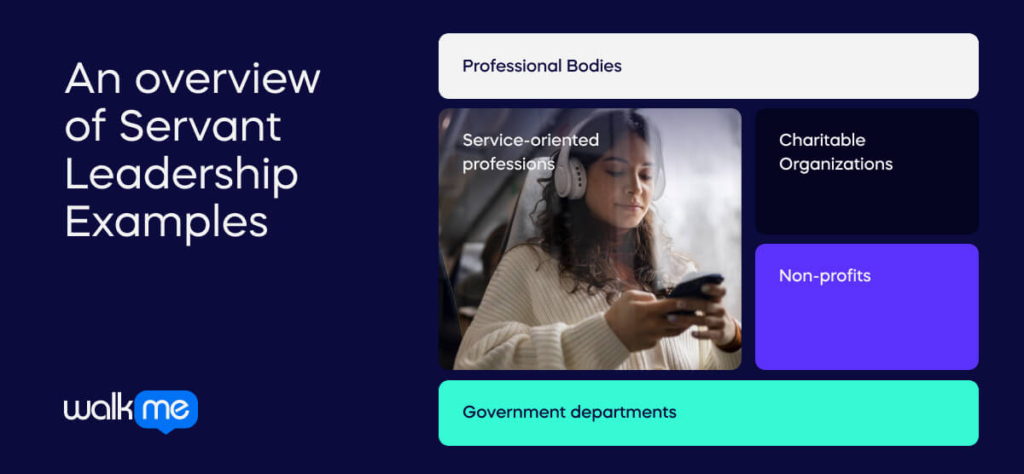You’re probably here because you want some practical knowledge about servant leadership.
We’re going to assume that you already know what a servant leader is and what the benefits of servant leadership are. You already know Richard Greenleaf’s writings on servant leadership from the 1970s.
Are you struggling to find practical guidance for servant leadership examples? Look no further. This article has got you covered.
Did you know that change management is one of the key components of servant leadership? A good servant leader constantly adjusts and adapts their approach to fit the needs of those they serve.
We’ve dug deep into libraries to find four examples that show you everything you need to know about servant leadership. Even if you don’t work in these sectors or departments, you’ll discover transferable knowledge in all of them.
Uncovering new leadership styles? Servant leadership offers a viable solution, whether for organizational development, performance management, or something else entirely.
We’ll be looking at servant leadership in the following areas :
- Sports Teams: We know you’re not planning to go to the Olympics soon. But if you want to know how servant leadership can improve high-performance environments with a tradition of authoritative leadership? this is the place to go.
- Law Enforcement: It’s pretty tough being in the police. Officers join out of a spirit of service. But they may then risk trauma, stress, and low promotion prospects. We’ll see how servant leadership can turn this around.
- Human Resources Management: This is closer to home for many business leaders – after all, every business needs someone to do HR. We’ll see how servant leadership in HR can positively impact the whole organization.
- Agile Team Leadership: Last, we look at how a whole team can be structured around servant leadership. Even if you’re not working in an agile environment – pay attention! We’ll see how servant leaders support collaboration, productivity, and engagement, which are important for every team.
If you’re googling for examples of servant leadership, you’ve probably realized that there is much unhelpful content out there. So just a warning. We won’t talk about Mother Theresa, Jesus Christ, or Abraham Lincoln. If they’ve inspired you? Great! But many leaders will like to see examples closer to their working lives.
An overview of Servant Leadership Examples

Servant leadership principles are applicable everywhere.
However, some organizations are built on servant leadership principles.
For example:
- Professional Bodies
- Charitable Organizations
- Service-oriented professions
- Government departments
- Non-profits.
In these structures, most staff are already service-oriented before starting their job. They will be more interested in people than profits. The management principles of servant leadership will be easy to implement.
Servant leadership in some teams will initially feel radical, subversive, or even counter-cultural. As we will see, servant leadership can still greatly help those teams.
But it’s worth knowing that servant leadership can begin with simple actions.
Here are some of the actions a servant leader might undertake:
- Visiting sick employees in hospital
- Removing tasks from staff to free them up for training
- Actively seeks staff development opportunities
- Actively seeking feedback, suggestions, and ideas (and acting on them)
- Allowing staff to take time off for family sickness
- Make themselves redundant (while making others redundant)
- Keep a strong moral compass
- Responding to well-being needs
Even traditional leaders can use some of these ideas to improve the well-being and outcomes of their staff. But let’s now look at some situations where servant leaders can create radical results.
Servant Leadership in Sports
It takes incredible commitment to become a professional athlete. However, that commitment is often exploited by power-hungry coaches. Servant leadership can give way to making a change.
Why Sports Need Servant Leaders
Globally, competitive sports have received negative attention in the past thirty years. Commercialization has been rampant. Athletes burn out quickly. Gender inequality has been rampant. Sports teams and individuals have not consistently taken a stand against racism.
Since the 2010s, it’s been clear that different leadership styles could help the sector take responsibility for its challenges. Servant leadership is a great alternative method to traditional leadership practices in sports.
Why It’s Tough to Make a Change in Sports
Powerful and charismatic leaders traditionally dominate sports leadership.
The top leaders are problem-solving individuals in a team, club, or organization. Their orders should be respected without question. Their focus on winning is relentless. After all, isn’t that the main aim of participating in competitive sports?
Sadly, a results-based leadership system can easily lead to abusive relationships, toxic environments, and low levels of social responsibility. Even worse, the “power model” of leadership is deeply embedded in sporting practice.
What Could Servant Leadership do for Sports?

In professional sports, success is essential in the short and long term.
Some of the changes in mindset might include:
- Understanding the ins and outs of athletes’ lives
- A healthy relationship with failure
- Remembering the core purpose of playing sports
- Providing tailored support for everyone.
These qualities still bring success – but without the expense of well-being.
In his 2019 Book Servant Leadership in Sport, Gregory Sullivan draws attention to several specific models that have been useful in promoting servant leadership in teams:
- The Butler Way is a model Butler University sports teams use that values teamwork, accountability, and humility. This encourages athletes to prioritize team goals over individual achievements and adopt a servant leadership mindset, leading to a positive team culture.
- Jowett’s “Coach-Athlete” model focuses on building strong relationships between coaches and athletes, using the 3 + 1 Cs: closeness, commitment, complementarity, and co-orientation. These priorities align with the coach’s and athlete’s perspectives.
- Cloud’s “Four Corners” approach emphasizes self-awareness, people skills, task skills, and character. The personal qualities corner highlights the importance of mentoring, building positive team culture, and recognizing the potential in team members.
- More generally, sports leaders benefit from self-awareness. To become servant leaders, they should know about their strengths, weaknesses, values, and beliefs. With this knowledge, servant leaders prioritize their team members’ well-being and growth and adapt their leadership style to meet their needs.
In short, many tools are available to improve leadership in sports teams. Indeed, Sullivan explains, “Servant leadership is playing an essential role in attempting to change the culture of the sport.” With servant leadership strategies in place, we can expect less burnout, more team building, and greater social responsibility.
Servant leadership in sports sets a great example for businesses: they reach for success but never forget their true purpose.
Servant Leadership in Law enforcement
Law enforcement represents a great opportunity for servant leadership. After all, police employees are often motivated by a spirit of community and service.
Challenges and opportunities in Policing
However, this is a very high-stress job with a great deal of public attention. And around the world in 2025, citizens are highly distrustful of police departments – putting a division between officers and the people they serve.
Within organizations, leaders can be focussed on administrative procedures, far from the “rank and file” action. And in this high-risk environment, there’s often hostility to change.
With this unique combination of challenges and opportunities, police departments have much to gain from effective servant leadership.
Servant Leadership in Local Police Departments
Servant leadership has been explicitly applied to police departments – with positive results.
- For example, the police department of Coppell, TX, switched to using a servant-leader model. A 2021 study examined the outcomes in detail and proved a positive connection between servant leaders and job satisfaction.
- A recent study from Utah Valley University investigated a department led by servant leadership characteristics. Employees were treated fairly, given open-ended opportunities, and support for family needs. Through interviews with serving officers, the researchers found that servant leadership behavior positively impacted employees’ personal growth, mental health, physical fitness, and belonging.
- Some more specific initiatives can be easily introduced. For example, community-oriented policing (COP) and problem-oriented policing (POP) are both models of policing that prioritize the needs and well-being of the community they serve.
Delivering Well-Being on the Front Line
In the high-pressure environment of police departments, servant leadership skills can bring a more personal touch. The team leaders make their employees feel accepted and understood. That’s pretty special in an environment that can be cut-throat, stressful, and traumatic.
In short, servant-led police departments support individuals in handling difficult situations.
Police officers must make uniquely difficult choices every day. But decision-making is a part of many job management roles. Create happy people, and they will perform better at whatever level they are working.
Servant Leadership in Agile Project Management
Leaders for Agile projects have a very distinctive role. A manager doesn’t set targets, micromanage, or set deadlines. Instead, scrum masters and project managers must support a team to self-organize. Agile leaders help each staff member to do a great job.
This role means that Agile goes very well with servant leadership.

In his 2020 book, Succeeding with Agile Hybrids, Shawn Belling explains how a servant leadership philosophy fits with agile project management, even saying that “Agile depends on a scrum master or agile project manager who understands and embodies the concept of servant leadership.”
The Challenges of Agile Leadership Skills
Agile is now a very widely used methodology – with great results. Yet adapting to agile working is not easy.
Leaders may ask themselves some of the following questions:
- If managers have learned top-down leadership styles, can they adapt to a new role as agile project managers?
- For people who are good at agile techniques, how do they lead in an organization that does not encourage agile across all departments?
- And finally – but most basic. The agile team leader’s job is to stand back and let the team do their work. What does this look like in practice?
The good news is, Agile leadership can start with some basic procedures from the servant leader playbook.
How a Scrum Master or Agile Team Leader serves Their Team
Agile team leaders serve their teams by creating a positive environment for efficient work. In practice, people must be encouraged to use self-organization and devolved decision-making.
At its simplest, this could involve several small tasks. Week to week, an agile leader’s work might include:
- Taking instructions from product owners
- Building consensus
- Facilitating daily stand-up meetings
- Collecting anonymous feedback
- Stopping interference from other sources in the company
- Providing material support for team members through snacks, drinks, and improvements to the working environment.
These are a host of tasks that almost seem trivial. However, these tasks are important for the velocity of the team. They help to inspire their agile team through responsibilities of all sizes.
Agile: Servant Leadership in Action
Agile is not identical to servant leadership – and agile leaders can still learn a lot, specifically from the servant-leader skillset. But agile reminds us what a true servant leader looks like. They work in a way that is radically different from bosses in a traditional leadership role.
Servant Leadership in Human Resources Management
Why are we looking at just one specific business function?
The answer: HR can set a good example for every other department in any organization. Companies may see a wider impact by using servant-leader principles in HR.
Moreover, HR leadership is an important topic. A 2024 survey from Gartner showed that leader effectiveness was among the top proprieties for HR departments. So, this is a great time to understand how HR functions can be improved with servant leaders.
Why Servant Leadership matters for HR
HR departments should serve the people of an organization. Developing individuals is, after all, their key task.
However, there is a risk of failure. In HR, using the language without delivering the values is possible. Even worse, HR could be completely wrong in their servant leader implementation. They can insist on discipline when there’s no real commitment: the letter, but not the spirit.
The truth is that true servant leadership comes from the mindset and values of leaders. A template is not enough: building deep relationships between staff and employees takes time and energy.
The Opportunity for Principled HR Management
One answer to the problems comes from Gary E. Roberts. He wrote the landmark analysis of Servant Leader Human Resource Management in 2014. Roberts outlines a deeply principled approach to HR management with servant leaders.
For Roberts, key principles include:

- Managers use humility to recognize, appreciate, and respond to different views and perspectives.
- Decisions are made using the Golden Rule: treating other people how we would like to be treated.
- Leadership encourages all employees to use ethics, morals, and empathy in their work.
- Most fundamentally, the company takes a “covenantal” relationship with staff. The organization protects its employees and takes responsibility for their safety and success.
Practical steps include:
- Difficult decisions may include sacrifice. For example, if the company faces financial difficulty, senior staff must be the first to go.
- Investing in the community. For example, the company should provide many resources to up-skill their low-wage workers.
- Openness to flexible working arrangements. HR should be ready to accommodate disabilities, family obligations, periods of sickness, and more.
Robert’s account of HR servant leadership is a great reminder of how servant leadership works in practice. Leading as a servant should come from deep and authentic principles. Servant leaders just don’t work without integrity.
Secondly, the fact that they must be seen in deliberate actions.
Servant Leadership for the Next Generation
Sometimes, “servant leadership” is just another trendy buzzword. That’s a shame! As we’ve seen, many organizations have proved that servant leadership works very well for many workplaces. The principles of servant leadership can take many forms: and real-life examples are essential to see how useful it is.
It is great to see that this style is more common today than when Greenleaf was writing. Servant leadership answers many problems of management today.
Just think of the potential of servant leadership. Servant leadership could be very useful even in an area like digital transformation. After all, you can only implement technology if you know what your staff thinks. In this context, digital adoption platforms could greatly support a servant leader’s encouragement.
Whatever field you’re in, think about servant leadership next time you decide how to manage a project.

